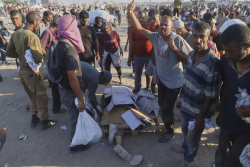The June 22 attack on the Mar Elias Church in Damascus underscores the threat of extremism in Syria even after the fall of Assad. The new government must demonstrate control and protect minorities.
An attack on a church on Sunday, June 22, killed 25 people in Damascus. The attack in Syria’s capital should mark a turning point in the new Syrian government’s approach to confronting extremism.
The new government has been in power for six months since the fall of the Assad regime in early December 2024. It has taken time for the government to consolidate power and appoint a new cabinet and interim president. The new government still doesn’t control all of Syria.
What Was the Mar Elias Church Attack?
The attack targeted the Mar Elias Church in Dweila, a Christian neighborhood in Damascus. Authorities believe a suicide bomber entered the church and carried out the attack. The Islamic State of Iraq and Syria (ISIS) is believed to have been linked to the attack, although a smaller extremist group has also taken credit for the assault.
This is a dangerous development because ISIS and similar extremist groups should not be able to carry out attacks in the heart of the capital of Syria. ISIS was largely defeated in Syria in 2019. The US-led Coalition against ISIS has backed the Syrian Democratic Forces in eastern Syria in operations against the group since 2015. The US has also supported a smaller group called the Syrian Free Army that operates in southern Syria. This group has now become part of the new Syrian army.
The massacre at the church has led to an outpouring of global sympathy. Countries in the Middle East condemned the attack.
In Syria, Christians have held ceremonies showing solidarity with their coreligionists, and Syrians of all faiths have expressed sympathy. This is crucial, as it demonstrates the new government’s commitment to identifying the perpetrators and protecting minorities. Syrian security forces said they had detained suspects in the attack.
Syrian state media SANA said that “Interior Ministry spokesman, Noureddine al-Baba, said on Tuesday that following a security operation based on preliminary information and in coordination with the General Intelligence Service, Syrian security units in Damascus countryside carried out an operation targeting the locations of the terrorist cell that carried out the bombing of Mar Elias Church in the Dweila neighborhood.”
Syria believes that the terrorists sent two suicide bombers. One targeted the church, and the other was supposed to attack a Shi’ite shrine located in a suburb of Damascus. More details may be revealed about the terrorists and their affiliations, although they are accused of being linked to ISIS, they may have affiliations with a smaller extremist group.
A group called Saraya Ansar al-Sunna also claimed responsibility for the attack.
Can the New Syrian Government Handle Threats Like the Mar Eleias Church Attacks?
The larger story of the attack reveals several challenges ahead for the new Syrian government.
First of all, it shows that extremists can penetrate the capital and target minorities. Minorities have also been targeted in other incidents in Syria since the new government came to power. For instance, the Alawite people have been killed in Latakia, and Druze have clashed with the latest security forces in southern Syria.
The new government has sought to assure Syrians and also the international community that it can stop these attacks. Some are skeptical because the government contains members of Hayat Tahrir al-Sham (HTS), the Syrian opposition group that played a key role in overthrowing the Assad regime. HTS was viewed as a terrorist group linked to Al Qaeda before coming to power. Some will ask whether former extremists help crack down on today’s extremists.
On the one hand, they might be the best placed to do so, because they understand how terrorist cells operate. On the other hand, their ranks may be infiltrated by other extremists.
The new Syrian state has taken months to consolidate its security forces. It has established new units and divisions. However, it has taken time for these units to take control of the countryside. Where there is a vacuum, there are opportunities for terrorists to take advantage. This is why groups such as the US-backed Syrian Free Army (SFR) must be integrated into the new divisions of the government.
Who Has a Legitimate Claim to Govern Syria?
Indeed, there are still challenges to overcome. The Syrian Democratic Forces (SDF) control approximately one-third of Syria, primarily located east of the Euphrates. This is also where US forces are operating. The SDF has agreed to integrate into the new Syrian army, based on a deal reached in March.
However, this takes time. In the wake of the attack on the church, Syrian authorities claimed several terrorists linked to the attack may have come from Al-Hol camp in eastern Syria. This camp, which houses ISIS families who were detained after ISIS collapsed in 2019, is home to thousands of ISIS supporters. The Syrian government and SDF have been in contact about Damascus taking control of the camp. The SDF has denied that the suspects in the church attack came from Al-Hol.
It’s easier for Damascus to blame the lack of security on the SDF because this will encourage calls for Damascus to speed up its demands to take over areas of eastern Syria and secure Al-Hol. On the other hand, the SDF were trained by the US and they have a long and positive track record hunting down ISIS cells. The new Syrian army will benefit from the SDF’s expertise when integration happens.
The aftermath of the attack on the church illustrates the need for the new government in Damascus to secure the countryside and the desert near the Euphrates River.
Iraq reopened a border crossing to Syria in mid-June. This means goods can flow back and forth, and also people can transit. However, ISIS and other extremists have also exploited a weakness in security along the Euphrates River valley that stretches from Syria into western Iraq. This means they may take advantage of the newly reopened border. Syria will need to deploy additional forces to this region near Albukamal and Deir Ezzor along the Euphrates River.
Another issue is southern Syria near the Jordanian border and the Israeli border on the Golan Heights. Israel has demanded that southern Syria be demilitarized. Recent reports indicate that Israel and Damascus have quietly improved ties behind the scenes. However, more will need to be done so that extremists cannot exploit the power vacuum in southern Syria near the Israeli border.
Can the Different Syrian Military Groups Work Together Peacefully?
Further, Damascus must find a way to integrate the SDF without creating tensions with the authorities in eastern Syria. This requires coordination with the US and also enabling integration that safeguards the SDF’s concerns. Better coordination will weaken the ability of extremists to exploit gaps between the SDF and government forces.
The US and other countries that have worked to engage with Damascus can play a positive role. US envoy Tom Barrack said, in the wake of the church attack, “the complex, multi-faceted Syrian identity will not be shattered by the cowardice of terrorists who seek to sow discord. The United States stands with all religions and elements of Syrian society as they build a brighter future that prioritizes inclusivity over division, stability over conflict, and tolerance over prejudice.”
To achieve this brighter future, coordination amongst security forces and continued support from the US-led coalition against ISIS are needed.
About the Author: Seth J. Frantzman
Seth Frantzman is the author of Drone Wars: Pioneers, Killing Machine, Artificial Intelligence and the Battle for the Future (Bombardier 2021) and an adjunct fellow at The Foundation for Defense of Democracies. He is the acting news editor and senior Middle East correspondent and analyst at The Jerusalem Post. Seth has researched and covered conflict and developments in the Middle East since 2005 with a focus on the war on ISIS, Iranian proxies, and Israel’s defense policy. He covers Israeli defense industry developments for Breaking Defense and previously was Defense News’ correspondent in Israel. Follow him on X: @sfrantzman.
Image Credit: Shutterstock/Mohammad Bash.


















